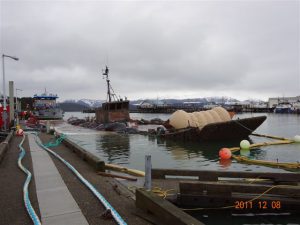Written by: Holly C. Wells

It seems each season a new television series pops up, magnifying the mystery of Alaska’s waters and the lucky men and women that build their lives around them. One story that remains untold, however, is that of the Alaska fleet and its very real need for a retirement plan.
Alaska vessels are the backbone of its commercial fishing, import/export, and tourism industries, which are all at the core of Alaska’s economic success. In 2014, the Alaska Department of Commerce reported that the majority of Alaska’s vessels were built in the 1970s and 80s and nearly 1,000 of the vessels in the Alaska fleet were over 50 years old. In other words, Alaska has a lot of old boats and old boats cause lots of new problems.
In 2009, I received a very rocky introduction to the Alaska fleet retirement problem. It was a late night call from a harbormaster, “a commercial fishing vessel just went down in the harbor, we’ve got it contained, now what?” Odd, I thought, why call the attorney? Was this a trick question? Get that boat out of the water, bill the owner, and call it a day! Well, that all happened, it just took years and a herculean effort by the Coast Guard, the city, private marine service providers, the EPA fund, scrap metal companies, and very careful navigation of constitutional state and federal laws. As it turns out, when it comes to dealing with derelict vessels, nothing is simple.
After that initial call, it seemed abandoned, sunken, or derelict vessels were drifting into coastal communities throughout Alaska and federal, state, and local entities were scrambling to address them. State agencies were hesitant to address the problem because of the legal uncertainties surrounding liability. The Coast Guard mobilized quickly when there were imminent signs of contamination but questioned jurisdiction to assist when immediate risk was low. Ultimately, the burden and the cost fell upon local coastal communities, many of which did not have local laws that addressed derelict vessels or processes for removing them. Everyone was frustrated and looking for answers. Over the next few years, I worked with numerous communities to ensure that the applicable local laws gave the harbormaster the authority and legal tools to deal with derelict, abandoned, and otherwise problematic vessels. Simultaneously, the harbormasters worked diligently to communicate with vessel owners and assist them in figuring out how to deal with their old vessels and possible options for financing the excessive costs of repairing, replacing or even disposing of a vessel. They talked with scrap metal companies, marine industry suppliers, and their harbor users about the problem and potential solutions. I even recall interesting discussions with scientists and engineers regarding artificial reefs. It was clear that Alaska’s fleet needed a retirement plan and fast.
In 2011, Homer’s Harbormaster Bryan Hawkins and I presented Homer’s challenges with derelict vessels at the Alaska Association of Harbormasters and Port Administrators. During the presentation, a dialogue began, driven not only by the frustrations and needs of Alaska’s coastal communities but by its vessel owners, state and federal agency attendees, and advocates for the maritime industry that continues today. Shortly thereafter, a derelict vessel task force with representatives and advisors from the U.S. Coast Guard, NOAA, the State Department of Natural Resources and Department of Transportation, municipalities, Alaska legislature representatives, and other stakeholders was born and, with the impressive mediating efforts of Rachel Lord from the Cook Inlet Keeper, the task force started the hard work of coming up with a cradle to grave plan for Alaska’s fleet.
The Alaska fleet is still aging at a rapid pace and Alaska still does not have the state and federal laws and funding to ensure its graceful retirement. However, today legislatures, the boating community, and federal and state agencies are listening to one another and working toward a common goal. While government entities work to safely and lawfully remove derelict vessels, they also understand the importance of protecting the rights of Alaska’s boat owners and assisting responsible owners with the consequences of their aging vessels. On the other side, as vessels enter their “golden years,” the Alaskan-based marine industry support service providers are motivating to keep Alaska’s fleet healthy and supplementing it with new expertly crafted vessels.
This is an exciting and harrowing time for Alaska’s fleet, but Alaska will no doubt navigate it masterfully so long as all of its stakeholders recognize the importance of the fleet and work together to create a retirement plan that protects one of our most valuable man-made resources, from cradle to grave.
